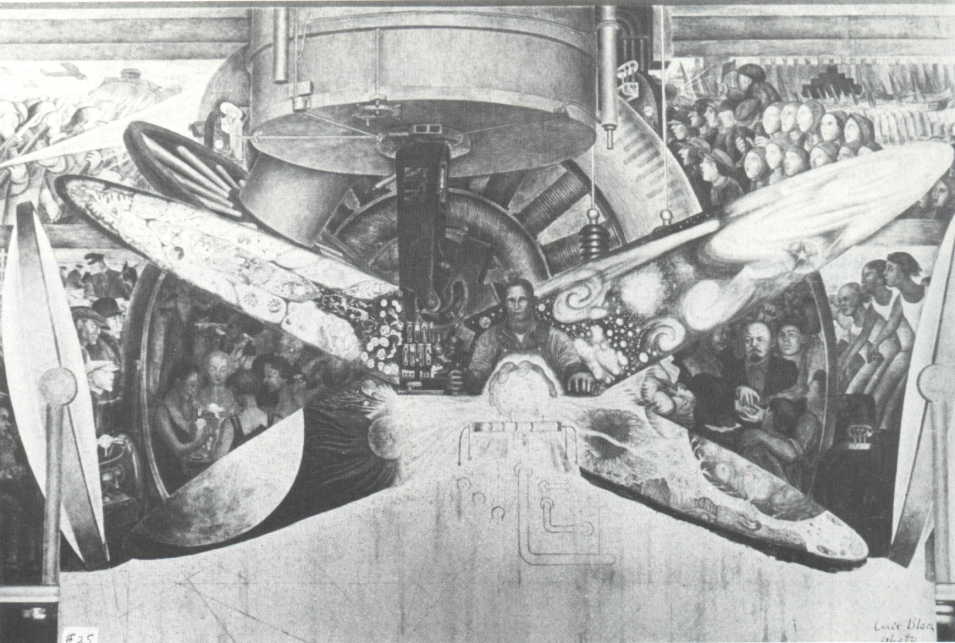Rockefeller Center

Man at the Crossroads- www.fbuch.com
Introduction
In 1931, Diego Rivera met Nelson Rockefeller after his Museum of Modern Art opened to the public and began talking about a prospective project for the Rockefeller Center. Rockefeller agreed to be a co-sponsor for the project. The true benefactor of the mural was the Todd-Robertson-Todd Corporation. They decided to place the mural in the “Great Hall” of the Rockefeller Center. From that meeting they reached an agreement and Rivera was set to continue his work regarding capitalism and the rising industrial system taking control of the economy in America. After initial negotiations, Rivera then talked to the architects to establish his limitations. At first, one of the architects, Raymond Hood, wanted the mural to be painted in monochrome. However, with Rockefeller’s support he was able to persuade Hood to allow him to paint with vibrant colors. Once this dispute was settled, a contract was signed in November of 1932 in which it was stipulated that for his services he would receive $21,000. Shortly after the completion of the Detroit Industry he arrived in 1933 with his sketches in hand. Even though there was a similar overall theme between the mural Rivera was planning for the Rockefeller Center and had executed in Detroit there was one major departure. In this endeavor he did away with the unification of man and technology. Instead he wanted to portray his view of a socialist future where man is “liberated” from the dependence of machines and takes control of his existence. Furthermore, he desired to create a world involving the blending of the macrocosm and the microcosm. The mural that he ultimately had in mind was a drastic alteration from the original sketches that were approved by both Rockefeller and the Todd-Robertson-Todd Corporation. It is through the preliminary stages of production that the plan evolved into the controversial piece that it is known for today. Regardless of the changes involving the promotion of Marxist ideas he still had the Rockefellers’ support. However he failed to consult the benefactors about his alterations. The impetus for this new direction is unclear. It is believed that the Communist Party of the United States questioned his integrity as a Communist and provoked him to represent more strikingly positive views of Communism in his work as opposed to tailoring it for the American public. Another possible reason for the final draft was the staunch support he received from the Rockefellers. The only portion of the mural that he changed was the center panel. The original plan for the two sides remained constant throughout the entire process.18
The Mural
The image on the right side of the wall was entitled The Frontier of Material Development. This part of the wall had a decapitated statue of Caesar with laborers surrounding him. These workers were allegedly supposed to be “inheriting the earth.” On the opposite side, The Frontier of Ethical Evolution, he had a bolt of lightning striking Jupiter’s hand. This imagery was used to represent, “human intelligence in possession of the forces of Nature.”17 The energy from the strike produced the solution to all of society’s problems. The final central panel maintained some of the original ideas. These concepts included the harnessing of the industrial force, the macrocosm, and the microcosm by an evolved society. In his final plan, he made a critique on the capitalist system and demonstrated its imperfections. He did this with an illustration of a man at the center of the intersection flanked by capitalism and socialism represented on his sides. On the man’s left there was dissonance and upheaval with people protesting the American economic system. Adjacent to the other side of the controller of the macro and microcosms showed serenity among a society immersed in socialism. Everyone was happily united as they joined hands together with Stalin, a leading figurehead of the socialist movement in Russia.
The main problem with the Rockefeller mural was the depiction of Vladimir Ilyirch Lenin. Diego was forced to stop painting, after only working a complete month on the mural. Rivera’s communist idealism came to be a very huge legal problem. First, the original sketch approved by the Rockefellers was distorted and Rivera inserted an image that did not appear in the original sketch. Second, the Rockefeller Center was to be used as offices during the depression where it was unlikely that capitalist owners would like the idea of arriving to work and seeing the face of Lenin. Rivera had an idea that his depiction of Lenin in the Rockefeller center was somewhat absurd, but insisted it was critical to his artistic vision for that mural. Trying to mediate the situation Nelson Rockefeller sent a letter to Rivera: “I noticed that in the most recent portion of the painting you had included a portrait of Lenin. The piece is beautifully painted, but it seems to me that this portrait…might very easily offend a great many people…. As much as I dislike to do so, I am afraid we must ask you to substitute the face of some unknown man where Lenin’s face now appears.”16 Rivera refused, and his contract was terminated on May 9, 1933. The mural was quickly covered with a white canvas. Months later the Rockefellers had the mural hammered off the walls on February 9, 1934.